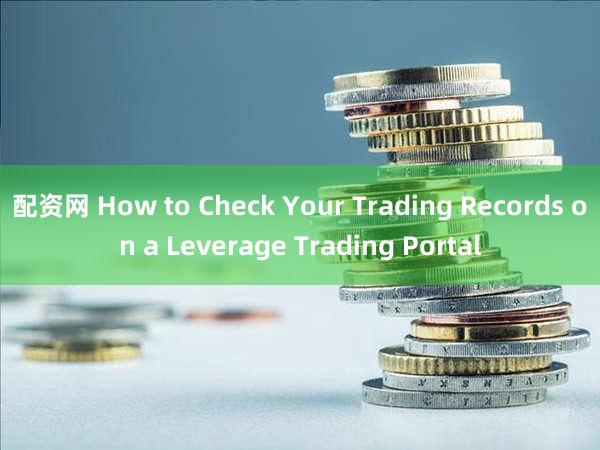
How to Check Your Trading Records on a Leverage Trading Portal?
Meta Description: Learn how to access and understand your trading records on leverage trading portals. This comprehensive guide provides step-by-step instructions and expert tips for navigating your investment history.
A Quick Guide to Navigating Your Investment Journey: Accessing Your Leverage Trading Records
So, you've been diving into the exciting (and sometimes nerve-wracking!) world of leverage trading. You're probably already familiar with the thrill of the potential gains, the heart-stopping moments of near misses, and the gut-wrenching feeling of a losing trade. But amidst all the adrenaline, it's crucial to keep a cool head and maintain a clear picture of your financial journey. And that starts with understanding how to access and interpret your trading records. This isn't just about crunching numbers; it's about gaining valuable insight into your trading strategies, identifying patterns, and ultimately, improving your performance. Think of your trading records as a financial roadmap 鈥?charting your progress, highlighting your strengths and weaknesses, and guiding you towards more informed decisions. Ignoring this crucial aspect is like driving blindfolded 鈥?you might get lucky, but chances are you'll eventually crash. This guide will equip you with the knowledge and tools to confidently navigate your investment history, turning your trading records from a simple log into a powerful tool for future success. Whether you're a seasoned trader or just starting out, understanding your past trades is the key to unlocking your future financial potential. Let's dive in!
Leverage Trading Portal: Accessing Your Trading Records
Finding your trading records on a leverage trading portal might seem daunting at first, but it's usually a straightforward process. However, the exact steps can vary slightly depending on the specific platform you're using. Most platforms prioritize user-friendliness, so you shouldn't encounter any major hurdles. Think of it like checking your bank statement 鈥?it鈥檚 all there, neatly organized, ready for your review. But unlike a bank statement, understanding your leverage trading records can provide invaluable insights into your trading style and effectiveness.
Here鈥檚 a general overview of what you should expect:
- Login: The first step, as with any online platform, is to log in securely using your credentials. Always ensure you're on the legitimate website to protect your sensitive information. Remember, security is paramount!
- Account Overview/Dashboard: Once logged in, you鈥檒l typically find a dashboard or account overview. This is your central hub, showing key metrics like your account balance, available margin, and potentially a summary of recent activities.
- Transaction History/Statement: Look for options labeled "Transaction History," "Trading History," "Account Statement," or similar. These are the treasure troves of your trading data. Clicking on this will typically bring up a detailed list of all your trades.
- Filtering and Sorting: Most platforms allow you to filter and sort your trading records. This is incredibly useful. You can typically filter by date range, asset type (stocks, options, futures, forex, etc.), or even profit/loss. Sorting options often include chronological order, largest to smallest profit/loss, and more. This level of customization allows you to pinpoint specific trades or analyze periods of high activity with ease.
What to Look For in Your Trading Records:
Your trading records should provide at least the following information:
| Data Point | Description | |-------------------------|--------------------------------------------------------------------------| | Trade Date & Time | When the trade was executed. | | Asset | The specific asset traded (e.g., AAPL stock, EUR/USD forex pair). | | Trade Type | Buy or Sell (Long or Short in leverage trading). | | Quantity/Volume | The number of units traded. | | Entry Price | The price at which you initiated the trade. | | Exit Price | The price at which you closed the trade. | | Profit/Loss | The net profit or loss from the trade. | | Fees & Commissions | All applicable fees and commissions associated with the trade. | 财盛证券| Leverage Ratio (if applicable) | Your leverage level for the trade (e.g., 1:5, 1:10). |
Analyzing Your Trading Records: Beyond the Numbers
Simply looking at the numbers isn't enough. Effective analysis requires critical thinking. Here's where you can leverage your records to improve your trading:
- Identify Winning & Losing Strategies: Analyze your trades to see which strategies consistently yielded profits and which led to losses. This allows you to refine your approach and focus on what works.
- Spot Emotional Trading: Review your trades to identify any patterns of impulsive decisions driven by fear or greed. Identifying these patterns is crucial for developing emotional discipline.
- Assess Risk Management: Examine your use of stop-loss orders and position sizing. Were your risk management techniques effective in limiting potential losses?
- Track Your Performance Over Time: Chart your performance over various periods (weekly, monthly, quarterly) to see trends and progress.
Remember, consistency is key! Regularly reviewing your trading records, even weekly, can significantly enhance your understanding of your trading performance and help you make better decisions in the future.
Common Questions and Answers (FAQ)
Q1: What if I can't find my trading records on the platform?
A1: Contact your leverage trading platform's customer support immediately. They can guide you through the process or troubleshoot any technical issues. Don't hesitate to reach out; it's their responsibility to help you access your data.
Q2: Are my trading records secure?
A2: Reputable leverage trading platforms employ robust security measures to protect your data. However, it鈥檚 still crucial to practice good online hygiene, like using strong passwords and avoiding suspicious links.
Q3: How often are my trading records updated?
A3: Most platforms update your trading records in real-time or very near real-time. However, there might be a slight delay, especially for large-volume trades.
Q4: Can I download my trading records?
A4: Many platforms allow you to download your trading records in various formats like CSV or PDF. This is beneficial for record-keeping and tax purposes. Check your platform's settings or help section for instructions.
Q5: What if I made a mistake in a trade? Can I correct it?
A5: Unfortunately, correcting past trades is generally not possible. Mistakes are part of the learning process. Focus on analyzing what went wrong and learning from it to prevent similar errors in the future.
Q6: My records show some discrepancies. What should I do?
A6: Contact your platform's customer support immediately to report the discrepancies. Provide them with as much detail as possible to aid in their investigation.
Conclusion: Mastering Your Trading Journey Through Data
Understanding how to access and analyze your trading records on a leverage trading portal is a critical skill for any trader, regardless of experience level. It's not just about tracking profits and losses; it's about gaining a deeper understanding of your trading strategies, identifying areas for improvement, and ultimately, maximizing your potential for success. Remember, consistency is key 鈥?regularly review your trading history and use the information to refine your approach. By mastering this aspect of leverage trading, you鈥檙e not just managing your finances; you鈥檙e charting a course toward informed and potentially profitable trading decisions. So, log in, explore your trading records, and start building your path to trading mastery!
文章为作者独立观点,不代表财盛证券观点






